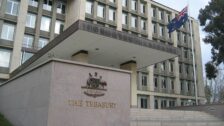To syndicate or not to syndicate?
If you are looking for one word to describe 2020, ‘volatility’ would seem to fit the bill. Every aspect of our lives, whether it be financially, socially, or work, has been like a roller-coaster ride. Into lockdown, out of lockdown. Often isolated from family or close friends. And then coping with investment markets that have been giving a good imitation of a yo-yo.
COVID-19 has driven us indoors, suspended our social lives and devastated businesses and personal incomes. That quaint phrase all those years ago by the Queen, when she described 1992 as her “annus horribilis,” comes to mind.
Many people have received JobSeeker/JobKeeper payments to tide them over, but others have not been so lucky, with senior Australians certainly among the latter, receiving very little financial help to bridge the gap between what they receive and what they need.
At the same time, many of these retirees are finding that the traditional asset allocation split between equities, property, bonds and cash is not necessarily doing them any favours in the current environment. Dividend income is under pressure, property faces several issues around rental income and capital growth, interest rates will remain at record lows, as will bond yields. In short, it’s a bleak outlook.
It’s time to think outside the square, to examine emerging sub-classes of assets that could provide better income and capital growth. And these investment options can come with other benefits such as diversification and social responsibility, and without the need to sacrifice liquidity or sharply increase risk.
Syndication (or fractional investment) puts another option on the table, allowing retirees (and other investors, for that matter) to invest in these assets at a lower entry price, as well as offering the opportunity to deliver diversification, minimise risk and increase returns.
Enter the family home. For those retirees with reduced income potential and diminishing super savings, their house may be their saving grace.
A key pillar of Australia’s retirement income policy into the future must be the family home (don’t be surprised if the Retirement Income Review spells this out in some detail), with the current parlous state of the economy and volatile markets almost making this inevitable.
For this to happen it, will become imperative for financial advisers to be involved in providing the necessary planning for our ageing population, many of whom are vulnerable, potentially open to “elder abuse” and possibly not armed with the necessary knowledge to make informed decisions.
The time is here and now, with a new fractional debt-free senior equity release available for investors to get a guaranteed long-term rental income and a share of the future capital value of a wide range of residential property.
The long-term nature of seniors’ equity release properties is ideal for self-managed super funds (SMSFs), which, by their nature, have a long-term outlook in the accumulation stage.
DomaCom, the pioneer of fractional investment in Australia, recently launched a new financial product in this space that delivers a debt-free option in equity release that also meets the needs of licensed financial advisers.
There are other options open to investors such as the Rent-to-Own market, where investors and tenants both benefit from a new investment model that shares the discounts that bulk-buying can deliver. Investors get immediate uplift in their investment and secure long-term tenants who are incentivised by getting an equity stake in the property they rent.
Disability and affordable housing are in high demand and can’t be built quickly enough to satisfy demand. Investors stand to benefit from government subsidised housing in the form of very low interest rates and/or subsidised rent payments to owners. Well worth a look.
For income, perhaps renewable energy projects are one way to go. Low on capital growth but high on the income side with a depreciable asset, renewable energy is here to stay.
For those with a longer-term time horizon, land-banking might be your cup of tea if you think rezoning for future use will increase values.
Another area that has done well for some DomaCom investors is rural farmland, a commodity that has appreciated well over the past few decades and one that attracts better rental income than most capital-city residential property. It’s also a “green” investment, as well as assisting our next generation of farmers to work the land without the pressure of large mortgages, allowing them to sow their capital more productively.
DomaCom’s fractional investment model also gives investors the ability to syndicate into loan or individual mortgage sub-funds to lend to specific properties or developments with first-mortgage security. For advisers, they can facilitate both sides of the transaction and DomaCom’s online secondary market provides liquidity.
DomaCom is helping change the shape of investing in many ways, providing financial advisers with multiple choices to allow clients to achieve their financial goals.
Written by Arthur Naoumidis, CEO, DomaCom.










